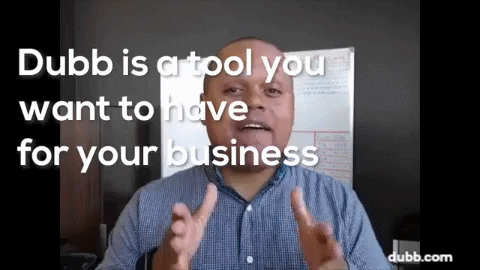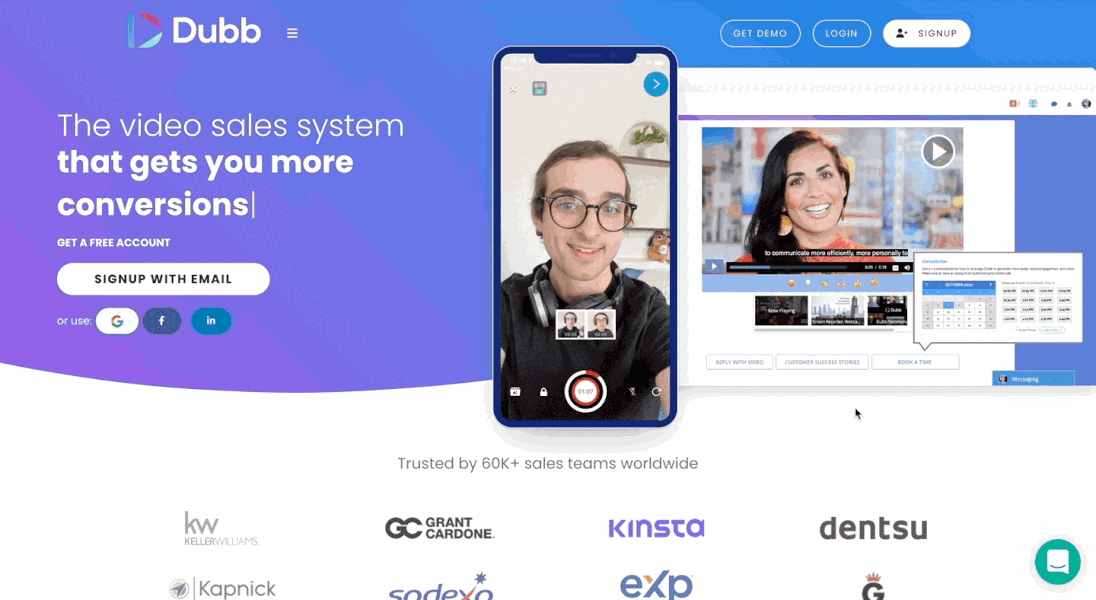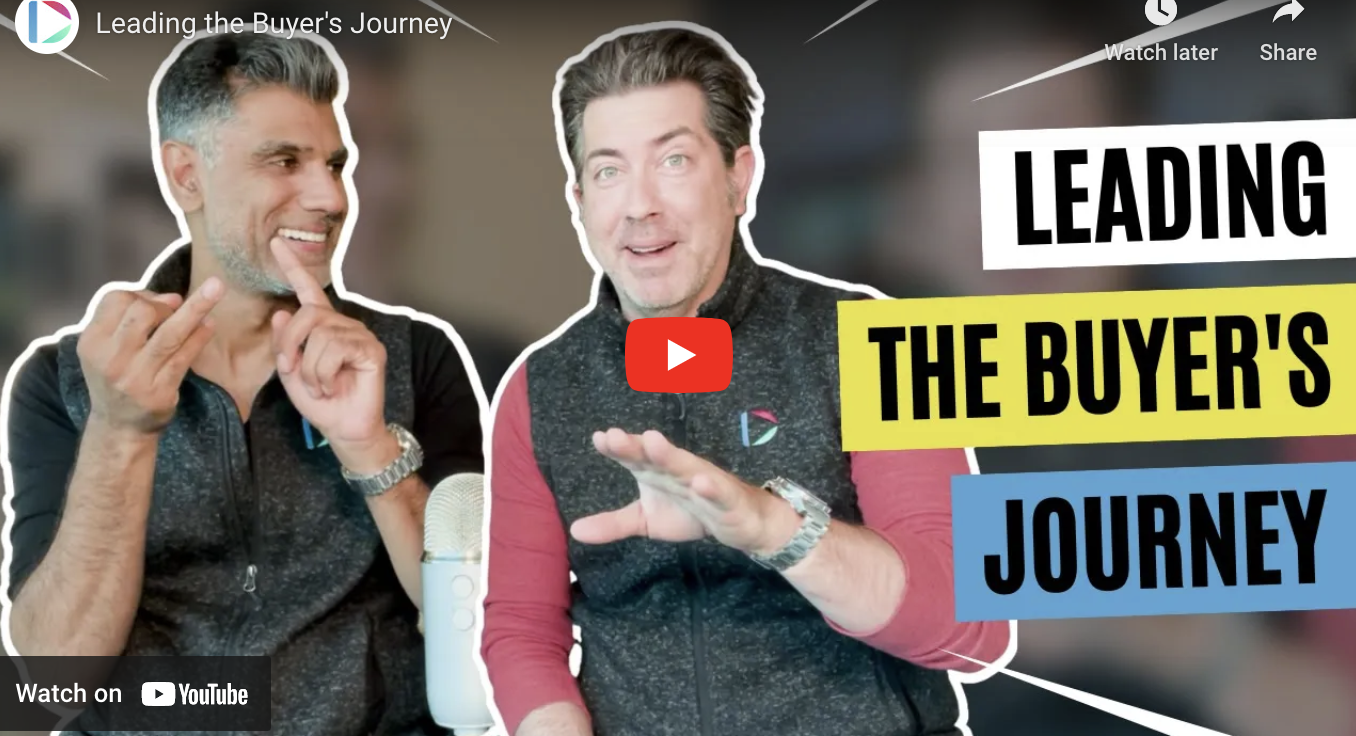In this recap from a recent episode of RevShow, Rob and I spoke about leading the buyer’s journey. It is an important topic for every sales professional. Whether you are the CEO of your company or a sales leader at a much larger organization, you can use the lessons in this post to supercharge your sales work. If you would like to watch the video in its entirety, go ahead and click on the play button above. Enjoy the conversation!
I’d like to start this post by asking you to join me in a hypothetical.
Picture this: we are in a car with another person. The buyer is the passenger. As the sales professional, you are the driver. The difference is that the buyer thinks they know where they want to go. You, on the other hand, actually know where they want to go.
The question, however, is whether they are going to trust you to get them there.
In this post, we are going to take a deep dive into leading the buyer’s journey. We are going to discuss what the concept is and how you can leverage it in your organization. It can help you build stronger relationships with your prospects, become more efficient with your time, and increase your conversion rates. It will also help you better understand buyer behavior, which can make you a much more effective sales professional.
Let’s get right into it.

Buyers Don’t Know What They Don’t Know
Leading the buyer’s journey is all about showing the buyer where they need to go and telling them how to get there. Ultimately, buyers don’t know what they don’t know.
To me, this is such an interesting topic. Henry Ford famously once said, “If I had asked people what they wanted, they would have said faster horses.” Along with this, Steve Jobs once said, “If I asked people what they wanted, they would have wanted a CD player that holds more CDs.”
The fascinating thing here is that consumers don’t always know what they want. They may think they do, but when they are presented with a certain product that didn’t immediately fulfill their assumptions or expectations, they may discover that the product vastly exceeded those assumptions or expectations.
Throughout this discussion, I encourage you to keep this thought in mind. Granted, it doesn’t mean that all customer or prospect feedback is irrelevant. In fact, there are plenty of people who should be paying closer attention to their prospects and customers. That being said, leading the buyer’s journey is about being proactive in this conversation. In certain circumstances, you may need to be a bit more upfront in showing the customer or prospect what they truly want. It is what it means to truly be leading the buyer’s journey and it is a skill that can massively pay off for you and your organization.
Three Types of Buyers
Ultimately, we are dealing with three different types of buyers in this discussion.
The first is buyers that don’t know they have a problem. The second type of buyer is a buyer that knows they have a problem, but does not know what the solution to that problem is. The third type of buyer is the buyer who knows they have a problem and thinks they have a solution. At least in terms of the third type of buyer, sometimes the solution is correct and sometimes the solution is not correct.
By understanding these three buyer profiles, you’ll better be able to understand their psyche. You can then figure out how to best communicate to them and how to convey the value that you and your company offer. Many times, the communication with these three buyers is very different. That said, the goal is still the same. That goal is to provide the maximum amount of education to that person. You want to lead with value and ensure that even if the prospect doesn’t buy your product or service, they benefited from the interaction.
At the end of the day, that prospect may not see the painting that you are seeing. Do you remember those old paintings that they used to have in your local mall? There would be a painting and inside of that painting, there would be an image. You would need to stand for hours in front of the painting to eventually see that image. Your job as a sales professional is to bring them right to that image as fast as you can.
One of the most famous artists who took on this style is the Dutch graphic artist Maurits Cornelis Escher. He has those amazing tile images where small fish connect with one another. It results in this big, beautiful thing that has entranced viewers for years. However, the amazing thing about his work is that there aren’t only fish in his images. There is another shape in there, which makes it twice as cool.
Ultimately, I encourage you to keep these three types of buyers in mind. Once you know the type of buyer that you are dealing with, understand their problems and help them see what you are seeing.
Leading Their Growth Journey, Not Your Growth Journey
Now that we understand the three different types of buyers, we’re going to talk about an important topic. That topic is all about leading your buyers’ growth journey, not your growth journey. It isn’t about your quota or the sales goals that you are trying to accomplish. Rather, your work is about the client.
So what does this mean in practice? When you are talking to them about their growth goals, make sure that you are actually focused on those growth goals. Yes, you may have some internal sales goals or objectives that you want to meet. After all, we have bosses and we need to help our businesses grow. But at the same time, focusing on their growth journey is going to actually get you closer to your sales goals. While it may seem somewhat counterintuitive, it works out in practice.
Recently, I was prospected by an agency. When they reached out, they delivered a promise to me. They said that if I invested in them, they would give me X results. What is interesting about this is that I decided to respond and ask about some pricing options. There was something that I found noteworthy. Even though they provided a solution to my short-term goals, they didn’t mention any of my long-term goals. Essentially, they didn’t ask what my ultimate goal was. For instance, it could have been lifting the brand up, increasing revenue, decreasing costs in some capacity, or something else. They failed to mention this fact.
I think this is a constant reminder that we must always be thinking about our client’s long-term goals. What are they ultimately trying to obtain? Is it to generate a more fruitful life? Is it to generate more revenue for their business or organization? Is it to cut costs or make their team happier? Whatever the ultimate goal is, stay locked in on that narrative. By doing this, you can make a connection with the client for the long term.
Ultimately, don’t make this about the sprint. Make this about the marathon. Just remember: in marathons, you have bursts of speed. What you want to do is help your prospects with their bursts so that you can get them to the eventual end of the marathon. When you look at the buyer’s journey as a sprint, you are implicitly accepting that there is a finality to the customer relationship. Instead, what you should do is look at the buyer’s journey as bursts of speed to help them get through their marathon.
The last point here about the growth journey is about mapping out a plan for long-term success. Just think about it: your solution may not be everything from A to Z. It may just be a part of the customer’s ultimate journey. However, the fact that you are tuned in to their long-term goals will mean that you have made a friend for life. This is because you legitimately care about their interests and their goals.
Nothing shows more caring than actually mapping out where they are physically going with their goals and what they want to accomplish. You can’t show someone where they are going to go unless you know the geography and landscape yourself. The fact that you know that landscape is inherently impressive.
Confiding = Connecting = Converting
When we are talking about leading the buyer’s journey, I like to bring up this phrase of confiding equals connecting equals converting. So what does this actually mean?
For starters, you may have to tell someone no throughout the sales process. However, if you say no, you may tell them what you do know. The key here is to say no when you need to stop a strategy that clients are using, but is not working. You may need to point this out, even if it seems uncomfortable to them. On the flip side, you need to use the concept of know when you recognize a better solution or a better way to help your client accomplish their goal.
Many times, clients may be listening to a certain type of “music.” They think that making that music louder will lead to a better strategy. As you can guess, this isn’t quite it. Even though it may seem like a problem of magnitude, the real problem is that the client doesn’t have the right music on. As sales professionals, we need to be trusted advisors. It’s critical to sit with a prospect or customers, really look at what they have, be investigative, and realize sometimes that you may need to say “No” ‘to this and “Yes” to that.
This is a really powerful attitude to take toward sales. You aren’t trying to play any game and get your prospects to move in entirely different directions. What you are instead telling them is, “This is not going to work. But don’t worry. Even if you may be upset about the ‘no,’ get happy about the ‘yes’ because the ‘yes’ is going to be better.”
When you tell someone, “This isn’t working, and you need to go this direction,” you will quickly discover how important trust is. Many times, our clients may actually think that they know what the solution is. Simultaneously, they may not know the most effective and efficient path to reach their goals. Sometimes, you may have to simply say ‘no.’ You will have to say, “Look, I would love to confide in you and tell you that there is actually a different path.” If you do this the right way, your prospects or customers will not feel like they’re being rejected. In fact, they will feel the opposite. They will feel rejuvenated. Critically, they will then trust you more. They will recognize your candor and intuitively understand that you are genuinely looking out for them. This trust is huge and will help you get much closer to a sale.
So the next time you want to say ‘yes’ to someone when you don’t agree with their underlying ideas, consider saying ‘no.’ Once you do that, provide a better solution that will help them better accomplish their underlying objectives or goals. You may be impressed with the outcome. Even better, you may win them over and convert an interested prospect into a customer for life. If you say the ‘no,’ make sure that you are providing the ‘know.’
Building Rapport Through Value
The next topic that we are going to cover in this discussion of leading the buyer’s journey is building rapport through value. To be clear, we are not building rapport before the value. This is all about building rapport through value.
One of the most popular ways of building rapport (which many people find effective) is finding a commonality. However, there is a caveat here. You want to find a commonality that has a purpose. So let’s say you have one thing in common with a specific prospect. Ask yourself: can I take that subject matter and show you value in that subject matter, but relating to what you do in your business? Better yet, can I take that and actually help you in your business? That is an example of taking something in common and relating it to how you can help.
Again, let’s assume that you have something in common with a prospect or client. In this hypothetical, I’m going to assume that you both love electric vehicles. That is a commonality and that can unite you and the other person. The other thing that is so powerful with this idea is that you have an opportunity to appreciate them. You have a chance to see them, respect their interests, and share stories that you both will enjoy.
The key here, however, is when you are going to build that trust and rapport with the other person, you have to be relatable with that story. You have to be relatable so that the other person knows what you are talking about. In other words, if I am speaking to someone and we’re both big Boston Celtics and Larry Bird fans, you can say something like, “I know we both love Larry Bird and the Boston Celtics. Do you know what Larry Bird would do in this situation if he was in your shoes? He would do X, Y, and Z. Bird used to practice, practice, and practice some more. We are going to be like him, practice our strategy, and I will show you how it is going to work.”
This is a pretty relatable way to connect a commonality with value that you and your business bring to the table. So ultimately, find that commonality related to the other person and use it to build value. Show how that commonality can lead to them reaching their business goals—whatever they are. That is how you get your clients to bleed green for you.
Prove It
Let’s be realistic for a second, however. None of this is relevant unless we prove that it works. In other words, we need to prove that our value proposition actually has wings. We need to show that people just like our prospects and clients have gotten the results that we promise.
This is why we always talk about generating social proof. At the end of the day, it is not what we say about our products, services, or companies. It is about what other people say about them. By other people, I’m specifically referring to past clients and customers. These stories are the most effective when it comes to persuasion. Just think about it: persuasion isn’t about how we persuade other people. It is about how we provide results to other people, who then persuade the people that we want to work with.
The other point here that your social proof can convey is the most important thing in sales. It isn’t just what you provide and what you can do, it is about how you make your prospects and customers feel in the process.
Don’t forget this. Persuasion comes from other people’s results. And results? They come from the happiness of those people. Once you have those satisfied people, you can use Dubb to gather some effective video testimonials. The magic comes from Dubb video landing pages. Once you have created a video for a specific audience, you can include a call to action button below your video. One of those call to action buttons can be a “reply with video” option, which lets your viewers easily record videos of their own and send them back to you. This can be a fantastic way to easily gather video testimonials and put them on a showcase page. At Dubb, the reply with video call to action is one of our favorites, so don’t hesitate to use it as you work to gather video testimonials and gather social proof.

Get Started Today
Leading the buyer’s journey is not a passive process. Even though it may feel comfortable to sit back and let the buyer figure things out for themselves, it can be massively beneficial to add your expertise and passion into the equation. On the surface, it isn’t rocket science, yet properly executing the tips and strategies above can add massive value to your prospects’ lives.
So go ahead and incorporate the advice above into your sales conversations. Don’t be afraid to ‘no’ and ‘know.’ And don’t forget that trust is a monumental part of leading the buyer’s journey. By keeping these ideas in mind and working with the prospects’ interests at the top of your mind, you will be in an outstanding position to build stronger relationships and generate more sales. I wish you the best of luck!

At Dubb, we love thinking about and discussing ideas like leading the buyer’s journey. If you have any questions about the ideas or concepts discussed in this post, click here. You can also click here to learn more about Dubb and click here to get a free 14-day trial of our premium plans.


